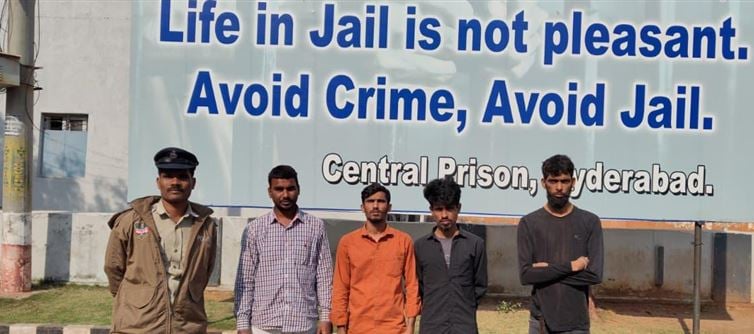
Four men walking at midnight in Hyderabad’s Tolichowki area were picked up, booked in petty cases, photographed, and remanded to custody — all for “roaming without a valid reason.” The images were uploaded online, outrage erupted instantly, and a single question tore through social media: When did midnight walking become criminal? The police responded with their justification — but the clash between public fury and law-and-order logic has now exploded into a nationwide debate on policing power, privacy, and civil liberties.
1️⃣ Arrested for Roaming? india Recoiled in Shock
News that four individuals were detained and sent to judicial custody for “simply roaming” past midnight hit like a jolt. Citizens wondered how walking at night — something as ordinary as breathing — suddenly qualified as grounds for custody. The visuals of their photos posted publicly only poured fuel on the fire.
2️⃣ The Real Outrage: Public Shaming Without Trial
Uploading photos of ordinary citizens online is not a policing achievement — it’s a privacy violation. And that’s where the outrage turned volcanic. people questioned: Since when do police stations operate like social-media PR units? The system looked less like law enforcement and more like a circus of poor judgment.
3️⃣ Civil Rights vs Crime Prevention — A New Flashpoint
For many, this wasn’t about four men — it was about the bigger fear that anyone could be detained on vague grounds, photographed, and showcased online. It raised uncomfortable questions about India’s policing practices, the overuse of “suspicion” as justification, and the growing normalisation of arbitrary detentions.
4️⃣ The police Counterclaim: “They Are Repeat Offenders”
Hyderabad police responded in a measured tone, saying:
“Police work for public safety and crime prevention. The 4 persons are already involved in many cases and have a Suspect Sheet. They were moving suspiciously. Further, we counselled them to change.”
This completely shifts the narrative. If these individuals indeed have prior criminal history, police action falls under preventive law. Yet the communication gap — and the manner of public display — made everything look like harassment.
5️⃣ The Real Problem: zero Transparency Until After the Outrage
Had the police clarified this context upfront, the situation might not have spiralled. Instead, the sequence played out backward: arrest → public humiliation → outrage → explanation. In today’s hyper-online age, lack of transparency is gasoline.
6️⃣ Midnight Policing Is Necessary — But Must Be Accountable
No one opposes preventive policing. What citizens oppose is unchecked policing. A democratic society demands:
clear communication,
restraint in public disclosure,
respect for privacy,
and proportional, lawful action.
When those elements are missing, trust collapses — even when police have legitimate reasons.
7️⃣ Public Fury Isn’t Just About This Case — It’s About a Long-Brewing Frustration
people are tired of:
arbitrary detentions,
overreach during routine checks,
humiliation instead of procedure,
inconsistencies in enforcement.
This case became the lightning rod, the trigger point. Not because it’s unique — but because it’s familiar.
8️⃣ This Controversy Should Push a Larger Conversation Forward
The Tolichowki incident is now a case study in how not to communicate, how not to handle public perception, and how quickly policing actions can backfire without transparency. india needs a clarified framework on:
how suspect sheets are used,
When preventive detention is justified,
and what limits exist on publishing citizen images?
This isn’t about being anti-police. It’s about being pro-accountability.
9️⃣ The Only Way Forward: Oversight, Clarity & Respect for Rights
Public trust is rebuilt not through force, but through clarity.
Police power is strengthened not by intimidation, but by legitimacy.
And security is enhanced not by secrecy, but by communication.
If this incident sparks reforms, then the midnight chaos may at least lead to daylight clarity.




 click and follow Indiaherald WhatsApp channel
click and follow Indiaherald WhatsApp channel